
The liberation of Czechoslovakia (modern Czech Republic and Slovakia) came from two different directions: Soviet troops advanced on the capital, Prague, in early May 1945, while US troops headed towards the industrial city of Pilsen.
Popular uprisings helped oust the German occupiers, who had been present in Czechoslovakia since the invasion of the Sudetenland in 1938.
Today the Czech Republic and Slovakia are two separate nations; in 1938 they were part of a single nation, Czechoslovakia, that included Czechs, Slovaks and Germans. Many of the country’s German speaking citizens lived in areas – collectively called the Sudetenland – that bordered Germany.
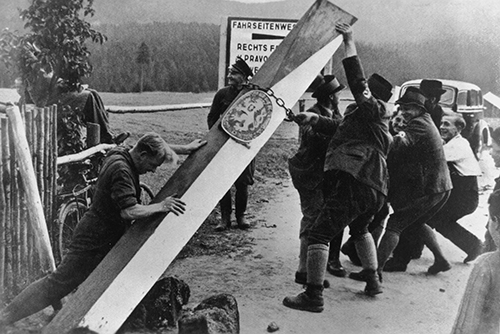
Credit: Getty Images
Markers of the Czech–German border are pulled down after the Munich agreement
Hitler saw this as a pretext for occupation. Presenting himself as the champion of the “oppressed” Sudetenland Germans, he demanded these areas be incorporated into Germany. Desperate to avoid war, the British and French caved in to his demands and persuaded the reluctant Czechoslovak president, Edvard Beneš, to do the same.
Hitler claimed the Sudetenland was the last of his territorial demands. Less than six months later, on 15 March 1939, German troops occupied the rest of the country. Offered the choice of cooperating or facing a full-scale invasion, the Czechoslovaks put up little resistance. The country was then divided: Slovakia became the Slovak Republic, a puppet state of Germany under the leadership of the fascist priest Jozef Tiso; the main Czech-speaking areas were turned into the Nazi-controlled Protectorate of Bohemia and Moravia.
To some extent, life for many Czechs continued as normal. The collaborationist government functioned under German control, but at the same time its prime minister was communicating with Beneš and the government-in-exile, supplying them with important intelligence.
Things changed in the Autumn of 1941 when the Head of Reich Security, Reinhard Heydrich, became the de facto ruler of Bohemia and Moravia. As an ardent advocate of Nazi racial beliefs, he regarded around half the Czech population as potential for Germanization; the rest were expendable. The small fortress town of Theresienstadt (Terezín) was converted into a transit camp/ghetto for the Protectorate’s Jews, and labour camps were established at Lety (southwest Prague) and Hodonín to intern the Romani population.
Many exiled Czechs and Slovaks served in the Allied armed forces, and in May 1942 two British-trained Czech agents assassinated Heydrich in one of the most daring resistance operations of the war (codenamed Anthropoid). Nazi reprisals, on Hitler’s instructions, were extremely brutal and included the total destruction of two Czech villages, Lidiče and Ležáky. Despite the loss of life, both the assassination of Heydrich and the later Prague Uprising of 1945 were seen as worthwhile, because they reinforced the validity of the Czech exiles in London and Moscow, and made them active partners in Allied discussions about their country’s future.
In early May 1945, as the Soviets advanced on Prague and US troops on Pilsen, popular uprisings broke out across the country in expectation of imminent freedom, including at Pilsen and Prague on 5 May. Almost all the fighting in Prague ended on 8 May with the German capitulation and withdrawal. The first troops from the Soviets' 1st Ukrainian Front did not arrive in the city until the following morning.
Significant sites
Significant sites are marked on the map
 Thank You America! Memorial,
Pilsen.
Thank You America! Memorial,
Pilsen.
 National Memorial to the Heroes of
the Heydrich Terror, Prague.
National Memorial to the Heroes of
the Heydrich Terror, Prague.

Credit: Liberation Route Europe
Commemorative celebrations of the Liberation, Pilsen
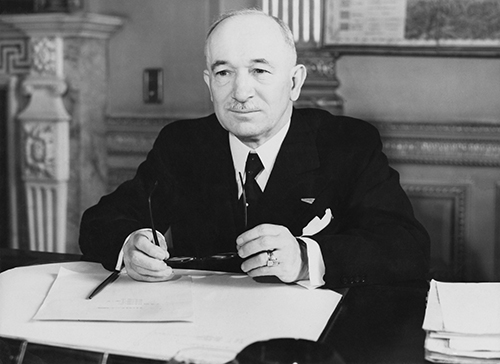
Credit: Getty Images
Edvard Beneš was one of the founding fathers of the new state of Czechoslovakia, a country born – like Poland – out of the wreckage of the Austro-Hungarian Empire in 1918. A socialist, but not a Marxist, his vision for Czechoslovakia was as a multi-ethnic state, which would act as a bridge between the communist east and the capitalist west. Beneš acted as foreign minister from the country’s founding in 1918 until 1935 when he became president.
By then, there was already discontent among Czechoslovakia’s minorities, especially the Germans and the Slovaks, who made up 22 percent and 16 percent of the population respectively. Beneš resisted Nazi Germany’s demand that the predominantly German areas, the so-called Sudetenland, be ceded to Germany. Italy, France and the United Kingdom disagreed, approving Germany’s annexation of the Sudetenland in the Munich Agreement of September 1938; Beneš was not invited to attend. Pressurized by France and the UK into agreeing the decision, and by Germany into resigning as president, he went into exile in October.
When war broke out, Beneš set up the Czechoslovak National Council as a provisional government-in-exile in Paris, transferring it to London after the Fall of Paris. He encouraged acts of sabotage and subversion by the remnants of the army at home, but the Czechoslovak Resistance was never as active as its Polish equivalent; its importance largely derived from its intelligence work, organized from London by František Morávec.
Beneš’s major foreign-policy aim was the re-establishment of Czechoslovakia after the war. Convinced that the Soviet Union would emerge as a dominant force in the postwar political landscape (and embittered by his country’s 1938 betrayal by Britain and France), he did his best to maintain good relations with Stalin, signing a Czech-Soviet Treaty of Alliance in July 1941. Beneš hoped that this would guarantee his own return after the war and the preservation of democracy.
Beneš did return to Czechoslovakia in April 1945, and later presided over the expulsion of 2.5 million Sudeten Germans. Democracy, however, only survived until 1948, when a communist coup established a one-party state – controlled by Moscow – that would last until 1989. Beneš, now a sick man, witnessed the loss of his country’s independence for the second time. He resigned in June 1948 and died a few months later. For Czechs, he remains a highly controversial figure.
On 4 May 1945, the 9th Infantry Regiment of the US 2nd Infantry Division – part of General Patton’s Third Army – broke through the eastern frontier of the Third Reich and entered occupied Czechoslovakia. Shortly before noon the regiment set up its command base in Neukirchen (Czech Nový Kostel).
The following day, the population of Pilsen (Czech Plzeň) rose up against the Nazi occupation. Citizens entered the streets and began to tear down Nazi symbols. As the Germans attempted to suppress the uprising, the civilian population called on the Allies for immediate assistance.
Early in the morning of 6 May, tanks from the US 16th Armored Division set out for Pilsen, reaching the city and its grateful citizens around 8.00am. The first unit into town was Combat Command B, led by Colonel Charles Noble. The Americans encountered sporadic resistance from German soldiers, and were fired on from the tower of the cathedral, but it soon became apparent that further fighting was futile. Around 2.15pm, Lieutenant Colonel Perkins, Noble’s second-in-command, received the capitulation signed by the German commander, General von Majewski, who then shot himself. The 16th Armored Division was relieved by the 2nd Infantry Division (nicknamed the “Indianheads”) and the 17th Belgian Fusilier Battalion, which included 700 volunteers who had joined the US Army after the liberation of Liège.
Many Sudeten Germans and German soldiers were desperate to avoid falling into the hands of the Soviet troops, and significant numbers fled into the US zone of occupation; once there, they had to be protected by the Americans from vengeful attacks by the Czechs.
General Patton was eager for his men to continue on to Prague to prevent Czechoslovakia falling into the hands of the Soviets. Churchill and many senior Americans were of the same opinion, but such a move (though easily achievable) was vetoed by Eisenhower as the western Allies' supreme commander. Czechoslovakia had been designated within the so-called Soviet sphere of interest at the Yalta Conference and he felt that to renege on this would create all sorts of political complications in the future.

Credit: Getty Images
US General George S. Patton makes a farewell speech to men of the 8th Armored Division prior to their demobilization in Rokycany
›› Porajmos: the forgotten Romani Holocaust
Romani people use the term Porajmos, meaning “the Devouring”, to refer to the Nazi attempts to exterminate them. Two labour camps, at Lety and Hodonín, were built by the Czechs in March 1939. From 1942 these were used to intern the Romani of Bohemia and Moravia, most of whom were later transported to the so-called “Gypsy family camp” at Auschwitz-Birkenau. Exact numbers are unknown, but an estimated four thousand were killed at Auschwitz and about 95 percent of Czech Romani perished overall. Recognition of the degree of persecution suffered by the Romani people has been slow to happen, and prejudice is still widespread. In 1971 a pig farm was built on the site of the camp at Lety; its removal was only agreed by the Czech government in 2017 after years of campaigning.
Probřežní 10, ![]() patton-memorial.cz/en
patton-memorial.cz/en
The Patton Memorial Pilsen museum was opened on 5 May 2005 to coincide with the 60th anniversary of the liberation of the city and southwestern Bohemia by the US Army. It contains over a thousand exhibits drawn from private collections, including archive photographs showing the war’s final days, with the arrival of US troops and their enthusiastic reception by the local population. Much of the exhibition focuses on General Patton and General Ernest N. Harmon, who assisted the postwar recovery of the country. The museum underwent a major refit in 2018–19, so check it’s open before visiting.
On a street named America, close to the junction with Klatovská třída, is the Thank You America! Memorial, erected to honour the US liberation of Pilsen. Two tall granite stelae with gold-leaf inscriptions in both Czech and English stand side by side up a small flight of steps opposite a fountain. In front of them is a separate smaller block dedicated to the 16th Armoured Division bearing the words, “We’ll Never Forget”.
A wedge of land at the junction of Klatovoská and E. Beneŝe is the site of the memorial to the 2nd Infantry Division. Conceived and designed by Dr Pershing Wakefield, a veteran of the division, it was erected in 1990 and takes the form of a small black obelisk with the division’s insignia – the head of an American Indian superimposed on a star (the division was known as the “Indianheads”).
This memorial, located opposite the Czech National Bank, is in the shape of a metal-framed glass pyramid. Etched on the glass is the division’s emblem.
Having been major participants in the fall of Berlin, Marshal Konev and the Soviet 1st Ukrainian Front were ordered to head southwest towards Czechoslovakia and on to Prague.
In support of Konev’s forces were Marshal Malinowsky’s 2nd Ukrainian and General Eremenko’s 4th Ukrainian fronts, advancing towards the southern and eastern borders of Czechoslovakia. This combined Soviet force of over two million men was opposed by around half that number of soldiers from the German Army Group Centre, commanded by the staunch Hitler loyalist, Field Marshal Schörner.
Before the Soviet advance had reached Czechoslovakia, Prague’s citizens spontaneously rose up against the Germans on 5 May – ahead of a planned operation by the Czech Resistance. German signs were ripped down and Czech flags raised. Radio Prague broadcast requests for Allied assistance, but although General Patton’s forces were closer to the capital than the Red Army, they were prevented from advancing by General Eisenhower.
›› Theresienstadt: the “model” camp
In November 1941, the 18th-century garrison town of Theresienstadt (Terezín), 64km north of Prague, was converted into a camp for Jews. The Nazis described it as a ghetto, but it was used as a transit camp for those ultimately destined for the gas chambers. The inmates included a large number of intellectuals and artists. Run by the SS, the camp was administered by a Jewish Elders Council who organized and encouraged a wide range of cultural activities. These were permitted by the SS, who used it to their advantage when an investigative commission of the International Red Cross visited the camp in June 1944. Theresienstadt was presented as a “model Jewish settlement”, complete with schools and gardens, an image reinforced by a Nazi propaganda film that was intended to counter the rumours of mass killings.
The day-to-day reality was very different: the camp was overcrowded, food was minimal, medical care inadequate and there were regular deportations to Auschwitz-Birkenau and other death camps. The SS fled on 5 and 6 May and Soviet troops arrived on 8 May. More than 155,000 Jews passed through Theresienstadt; around 35,440 perished there and 88,000 were deported to extermination camps.
Once German reinforcements arrived from Army Centre North, the reaction to the uprising was wholehearted and vicious. Help for the Czechs came from an unlikely source when, on 6 May, a division of the Russian Liberation Army (ROA) arrived. This anti-communist army – known as “Vlasov’s Army” after its commander, General Andrey Vlasov – had been fighting for the Nazis, but changed sides in a desperate attempt to save its own skin.
Although the German unconditional surrender was signed on 7 May, a short period had been granted for ongoing offensives to be terminated. The SS in Prague used this time to wreak as much murderous havoc as possible. In one instance, they massacred around fifty resistance fighters who had surrendered. Although the ROA proved effective at thwarting some German progress, by the 8 May its troops had abandoned the city to surrender to the Americans. German troops were similarly reluctant to fall into the hands of the Soviets and fought on before an agreement was brokered with the Resistance. This allowed most of the Germans to evacuate westwards on the morning of 9 May before the arrival of the Red Army’s 3rd and 4th Guards Tank Armies – the first Soviet troops to enter the city. The precise casualty figures of the uprising remain unknown: an estimated 1700 Czechs were killed and around the same number wounded; the Germans lost around 900 men; troops from the ROA about 300; while Red Army casualties in Prague were no more than thirty.
Over the next two days, Soviet forces to the east of Prague battled against the remaining Wehrmacht troops in the Protectorate, taking about 600,000 as prisoners-of-war. On 11 May the Soviets met up with elements of the US Third Army near Pilsen. While the war in Europe was officially over, hostilities continued against Sudeten Germans and Czech collaborators, violent attacks that were encouraged by Beneš and the Soviets. Thousands were killed and even more – perhaps as many as 2.5 million – were forcibly expelled from the country.
National Memorial to the Heroes of the Heydrich Terror
St Cyril and St Methodius Cathedral, Resslova 307/9a, Prague
Built for Catholic worship in the 18th century, this building became the cathedral of Czech Orthodox Christians in the 1930s. It was the only church to give refuge to the escaping Operation Anthropoid agents after their assassination of Heydrich in 1942. A section of the crypt contains an exhibition outlining the events, with memorial busts and brief biographies of the seven paratroopers who took part. Outside, on the bullet-marked south wall, is a plaque that commemorates those who died. A separate memorial in the Libeň district, on the actual site of the attack, is near a very busy road intersection and difficult to access.
Part of the vast Olšany cemetery, created in 1680 for plague victims, the military cemetery is within the northeastern section, 200m along Jana Želivského. Its centrepiece is the monument to the 436 Soviet soldiers killed during the liberation of Prague and its aftermath. There is also a mass grave containing two generals and 187 soldiers of the Russian Liberation Army who aided the Czechs during the Prague Uprising, and the graves of 256 British and Commonwealth soldiers gathered from across the Czech Republic.
In 1941, the population of Terezín was ejected and the garrison town turned into a Jewish ghetto and transit camp. Today, some of it functions as a museum, memorializing those who lived and died here. Made up of two fortresses, the larger is laid out in a grid plan. Near the main square are the remains of the railway siding where prisoners arrived and departed. The ghetto museum, housed in a large neo-classical building, outlines the history of the ghetto and its place in the “Final Solution”. The Magdeburg Barracks site, south of the museum, was where the self-governing Jewish council was located. The displays here focus on the camp’s remarkable cultural life, but there is also a reconstructed women’s dormitory – the three-tier bunks, luggage and belongings conveying some idea of the cramped conditions. The smaller fortress, just across the River Ohře, was built as a prison and used by the Gestapo to intern around 32,000 prisoners – mostly non-Jews active in the Resistance.
›› Operation Anthropoid: the plot to kill Heydrich
In October 1941, František Moravec, the Czech head of military intelligence in London, devised a plan (codenamed Anthropoid) to assassinate Reinhard Heydrich, whose ruthless control of the Protectorate had earned him the nickname “the Butcher of Prague”. Trained by the British Special Operations Executive (SOE), two agents, Jan Kubiš and Jozef Gabčík, landed near Prague. After various failed attempts, the pair ambushed Heydrich’s open-topped Mercedes in the Prague suburb of Libeń on 27 May 1942. When Gabčík’s sten gun jammed, Kubiš threw a grenade, injuring both Heydrich and himself. An exchange of fire followed before the injured Kubiš escaped by bicycle. Heydrich died eight days later from sepsis after his wounds became infected.
Furious that so senior a Nazi had been attacked, Hitler ordered massive reprisals. The villages of Lidice and Ležáky – thought to have links to the assassins – were singled out for particularly brutal treatment. Both villages were completely destroyed and most of their inhabitants murdered. The Gestapo tortured and executed many others suspected of involvement; as many as 1300 were killed.
Kubiš and Gabčík, along with five other Anthropoid agents, managed to evade capture until 18 June. They ended up sheltering in the cathedral of Sts Cyril and Methodius in Prague, but were betrayed by fellow agent Karel Čurda. The group held out against Waffen-SS troops for a few hours, but their situation was hopeless. The Germans were keen to capture them alive, but on entering the building they found Kubiš dying from his wounds, and Gabčík and the other five dead by their own hands.
Tokajická 152, Lidice, ![]() lidice-memorial.cz/en
lidice-memorial.cz/en
The massacre at Lidice – ordered as a reprisal for Operation Anthropoid – so horrified world opinion that several places were renamed after the village so that its name wouldn’t disappear. During the attack, 173 men were shot; the same number of women were sent to Ravensbrück; and 82 children were gassed at Chełmno extermination camp. The village itself was rebuilt nearby in 1945 and the site of the old village turned into a memorial and a museum. There’s a paved “reverent” area and mausoleum close to the museum, but much of the site is a green open space dotted with sculptures, including a poignant bronze group of the 82 murdered children. The museum uses archive material and film to evoke the everyday existence of those who lived here. Recently, one of the houses in the new village opened as a museum, continuing the Lidice story after the war, when 143 of its original female inhabitants returned.


Western consciousness of the war’s end, in particular the Liberation of Europe, is strongly focused on the Anglo-American achievement. But the actions of the Soviet Union were highly significant too.
The Soviet contribution, if acknowledged in western discourse at all, is coloured by the fact that in “liberating” the countries of Central and Eastern Europe, the Red Army overthrew one kind of brutal tyranny, Nazism, only to replace it with another – Stalinism. And yet the extent to which the Soviet Union suffered in helping to defeat the Nazis is truly staggering. During the four years of its war with Germany, in which it came perilously close to defeat, the country lost an estimated 26 million of its citizens – around fourteen percent – of which some 10.5 million were soldiers. The land war was fought, for the most part, on Soviet territory; something that the country’s two main allies never had to experience.
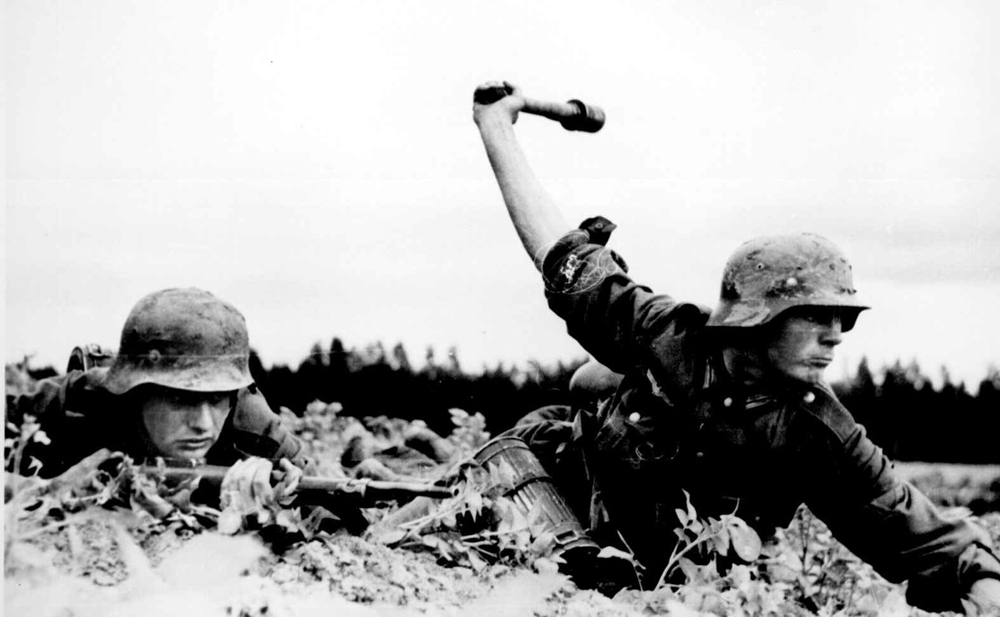
Credit: Getty Images
Troops in action during Operation Barbarossa
The German invasion of the Soviet Union in June 1941, codenamed Operation Barbarossa, came as a surprise to Stalin, despite many reliable warnings from his and other intelligence agencies. His armies were mostly unprepared. The invasion began less than two years after the signing of a non-aggression pact between the Nazis and the Soviets, who – though ideological enemies – were willing to make an agreement in order to divide up Central Europe between them. Hitler reneged on the pact in the confident belief that his seemingly invincible armies would reach Moscow before winter set in. Initially at least, his confidence was rewarded. During the summer, three German Army Groups of 153 divisions and 3.5 million soldiers (around eighty percent of Hitler’s total forces) swept eastwards in a series of fronts that stretched from Finland to the Black Sea.
Because they regarded Slavic people as barely human, the Nazis treated those they conquered with extreme barbarism, ransacking and burning villages, raping and murdering at will. Commissars, and any officials connected to the Communist Party, were automatically executed, and millions of POWs and workers were transported back to Germany as forced labour. Organized executions were carried out by Himmler’s mobile death squads, the Einsatzgruppen, with the most systematic violence directed against Jews and Romani. Some of these murders were on an unbelievably massive scale, such as the Rumbula massacre near Riga in which 25,000 people (nearly all of them Jews) were shot over two days. In many cases the Nazis recruited locals both to assist in the killings and to fight against the Soviets.
Why was the Red Army, despite its size, at first so inadequate to the task of defending the country? One answer is the sheer efficiency of the Wehrmacht which, once again, employed the tactic of blitzkrieg to devastating effect. Another is that Stalin’s purging of the officer corps in 1937 had seriously undermined the Red Army’s effectiveness and weakened morale. Among the many executed were three Soviet marshals, including Marshal Tukhachevsky, a key strategist and expert on armoured warfare. Other senior officers were imprisoned, such as Mikhail Rokossovsky, who after his release became one of the key commanders in the eventual defeat of Germany.
Shortly after the invasion, the Supreme Command Headquarters (the Stavka) was established to improve and coordinate the running of the armed forces, with Stalin as its Supreme Commander. Stalin then had something of a personal crisis, retiring to his dacha for a few days and only returning when asked to by the Politburo. Like Hitler, Stalin felt he knew how to conduct a war better than his generals, and (also like Hitler) would not countenance the idea of a tactical retreat. But at least at this point he was surrounding himself with some talented advisers: notably Georgy Zhukov, who would emerge as the Soviets’ most successful commander. Stalin’s interference was initially incessant, with NKVD men appointed to check and monitor the behaviour and performance of senior officers. General Pavlov’s failure to defend the Western Front in the first week of the invasion led to his arrest and execution within a month. As the war progressed, Stalin started to listen to his generals more intently.

Credit: Getty Images
Joseph Stalin (centre), flanked by his Foreign Minister Molotov (left) and General Zhukov (right)
With many Soviet troops surrendering in the face of the Germans’ implacable advance, Stalin issued Orders 227 and 270, authorizing extreme measures against any soldiers (and their families) who were captured or retreated. At the same time, Stalin was calling on the population to defend “Mother Russia” in terms of an apocalyptic fight for survival. For the Soviets – and for many Russians today – the conflict was thought of not as World War II but as the Great Patriotic War. Stalin recognized that appealing to the national pride of his citizens would have better results than any ideological arguments, even softening his attitude to the Orthodox Church. His citizens responded, and millions fought with dogged resilience. Even so, the forward thrust of the German Army Group Centre towards Moscow looked unstoppable, and was only ended when Hitler (to the frustration of his generals) ordered some of its divisions south to the Ukraine and north to attack Leningrad. The subsequent Siege of Leningrad would last nearly two and a half years and result in over half a million deaths, mostly from disease and starvation.
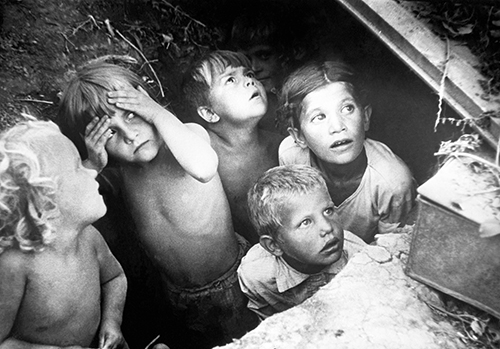
Credit: Getty Images
Children hide in an air-raid shelter during Nazi air strikes
What halted the advance and scuppered Hitler’s plan for early victory was the weather. By early October the rains had begun, reducing the roads to quagmires of thick, sticky mud; the conflict became literally bogged down. In addition, the German supply lines were badly stretched, the Soviets were now launching counteroffensives and had upped their industrial production levels, relocating their armaments factories further east and out of bombing range. They were also receiving much-needed materials and equipment from the British, and later the Americans, as part of the Lend-Lease scheme. Above all, with a population of around 190 million, Soviet frontline troops – which included women in important combat roles – could always be replaced, as soldiers were killed or captured. They needed them, as by December the ratio of soldiers killed was twenty Russians to every one German.
As the ground froze in November 1941, it seemed inevitable to almost everyone involved that Moscow would finally be taken by the Germans. That it didn’t happen was due to a resolutely determined defence, organized by Zhukov, that at times bordered on the suicidal. In December, the Russians launched a counteroffensive, followed by a large general offensive – ordered by Stalin – which met with failure. As Russian troops ventured into territory that had until recently been behind German lines, they witnessed the devastation and carnage that the invading forces had brought to villages and towns. What they saw inspired a deeply held thirst for revenge that would manifest itself in extreme reprisals (including systematic rape) as soon as Soviet troops reached those Reich-occupied territories beyond the Soviet Union, intensifying as they encountered actual Germans – whether soldiers or civilians.
Significant though the defence of Moscow was, the true turning points on the Eastern Front occurred in 1943: first came the terrible, attritional 23-week grind of the Battle of Stalingrad (modern-day Volgograd) which ended in February 1943; followed five months later by the Battle of Kursk, a vast armoured encounter involving 6000 tanks, 4000 aircraft and around two million troops. These two battles ended in Soviet victories, with massive losses suffered on both sides. They marked the end of the vast German campaign in the east and shattered the myth of the Wehrmacht’s invincibility. From now on it would be the Soviets who would be on the offensive.
As the Red Army pushed the Wehrmacht back and the defeat of the Axis seemed highly likely, Stalin began negotiating with his two allies about how the war would end and what a postwar Europe would look like. The first of the so-called “Big Three” conferences, at which Stalin, Roosevelt and Churchill convened together for the first time, took place in Tehran at the end of November 1943. Although military matters were the main discussion point, in particular the timing of Operation Overlord, Stalin was insistent that the frontiers gained by the Soviet Union’s invasion of Poland should be retained and signalled his contempt for the Polish government-in-exile.
In February 1945, at Yalta in the Crimea, the three leaders met again. Roosevelt, now clearly a very sick man, wanted to secure Soviet assistance against the Japanese and was largely uninterested in European affairs. Once again, Stalin quietly manipulated the other two leaders, managing to secure a dominating role for the Soviet Union in Eastern and Central Europe, with the matter of the precise makeup of the Polish government to be decided later in Moscow – something most Poles saw as a betrayal. Churchill also agreed to the enforced repatriation of all former Soviet POWs, including those who fought for the Nazis (which would guarantee their certain death). The Potsdam Conference held later in the year confirmed many of the decisions reached at Yalta and established precise zones of occupation in Germany.
A vast Soviet victory parade took place in Moscow in June 1945. Marshal Zhukov, who had played such a major role in the defeat of Germany and who had accepted the country’s surrender, was conspicuous on a white horse, but his triumph proved relatively brief. Although he attended Potsdam and was put in charge of the Soviet zone of occupation, the NKVD was already pursuing him. An incriminating trainload of war booty led to his downfall. The ever-paranoid Stalin, who saw Zhukov as a rival, was almost certainly behind the general’s fall from grace.
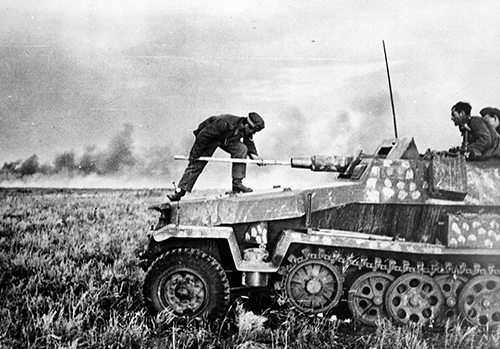
Credit: Getty Images
An armoured fighting vehicle at the Battle of Stalingrad
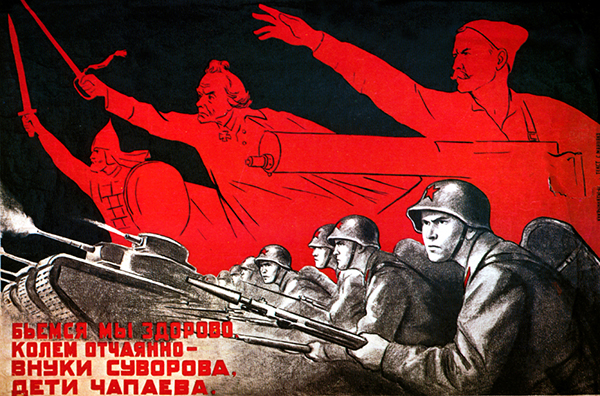
Credit: Getty Images